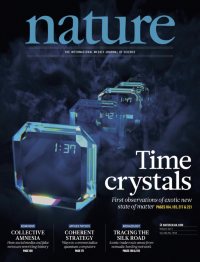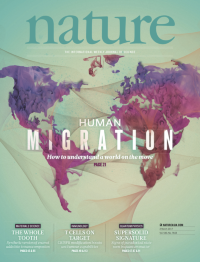Volume 543
-
No. 7647 30 March 2017
The cover shows an artists impression of cancer stem cells metastasizing through the blood stream. Cancer stem cells are thought to be the driving force behind tumour growth and metastatic dissemination, but experimental evidence is lacking for many types of cancer. Felipe de Sousa e Melo and his colleagues reveal that in colon cancer, plasticity renders Lgr5+ stem cells dispensable for primary tumour growth. When the researchers removed the cells from the system, they did not see the anticipated regression instead tumours were maintained by Lgr5 stem cells. However, the team found that metastatic dissemination and growth in the liver was greatly impaired, signifying that Lgr5+ cancer stem cells are crucial for this process and so might be a target for managing metastatic disease. Cover image: Allison Bruce
-
No. 7646 23 March 2017
The cover shows an artists impression of the ornithischian dinosaur Kulindadromeus looking up at a falling asymmetrical flight feather from the Archaeopterygidae family. Such feathers are known only in theropods, but if the hypothesis of dinosaur relations set out by Matthew Baron and colleagues in this issue is confirmed, this distinction will have to be revisited. Baron and his co-workers suggest that the accepted division of dinosaurs into two groupsthe Saurischia and the Ornithschianeeds to be redrawn. The Saurischia includes carnivorous theropods such as Tyrannosaurus rex, and the giant sauropods such as Diplodocus; whereas the Ornithschia includes ornithopods such as Iguanodon, and armoured dinosaurs such as Triceratops and Stegosaurus. Baron and colleagues challenge this grouping based on early ornithischians and suggest that sauropods should be grouped with the early, carnivorous herrerasaurs, but that ornithischians should be grouped with theropods.
-
No. 7645 16 March 2017
The cover shows bleached corals on the northern Great Barrier Reef in 2016. Work by Terry Hughes and colleagues has revealed that the cumulative footprint of multiple bleaching events has expanded to encompass virtually all of the Great Barrier Reef in the past two decades. The bleaching event in 2016 was the most severe, affecting 91% of individual reefs. Hughes and his team used aerial and underwater survey data combined with satellite-derived measurements of sea-surface temperature to assess changes in the geographical footprint of recurrent mass bleaching events. Their results reveal just how badly climate change is affecting the Great Barrier Reef, and they argue that immediate global action is needed to secure a future for coral reefs. Cover image: Edward Roberts, Tethys Images
-
No. 7644 9 March 2017
The cover shows an artists impression of time crystals. Much like ordinary crystals, time crystals exhibit a high degree of structural order. But whereas ordinary crystals get their periodicity from the regular repetition of spatial elements, time crystals are an exotic state of matter in which the same structures repeat themselves in time. Predicted to exist a few years ago, time crystals have so far resisted experimental demonstration. Now, two groups offer evidence for experimental observation of this elusive form of matter. Mikhail Lukin et al. have produced a discrete time crystal using a nitrogenvacancy system in diamond as an experimental platform. In a complementary paper, Jiehang Zhang et al. achieve a similar feat using trapped ions. Such time crystals could potentially find applications in robust quantum memory. Cover artwork: Peter Crowther
-
No. 7643 2 March 2017
In this special issue on human migration, Nature investigates the facts behind the headlines on migration and speaks to refugee and immigrant scientists. Vivek Wadhwa celebrates the foreign-born entrepreneurs who have brought jobs and wealth to America. And Hubb Dijstelbloem and Gemma Galdon-Clavel highlight ethical issues around the increasing use of technology to track peoples movements. Cover art: Alberto Seveso





